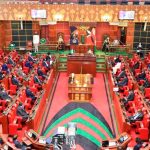Experts in water sustainability are warning against imprudent utilization of water resources in the country. According to the experts, the need for sustainable use of water especially in Kenya which is a water-scarce country, cannot be overstated.
While making a case for the widening of the ambition of the water agenda, they argued that with a per capita water availability of less than 600 cubic metres, which is below the global threshold of 1,000 cubic metres per capita, Kenya has no option but shift away from the present trajectory and change fortunes in the water sector. And indeed, something is being done.
Organizations such as the World Wide Fund for Nature Kenya, for instance, have organized an event dubbed “the journey of water” in a bid to sensitize communities upstream and downstream on the need to use the commodity prudently.
“The Journey of Water is a national campaign that aims to raise public understanding of water as an invaluable natural resource which is severely constrained,” says the organization.
The campaign focuses on the conservation of rivers from their sources through to the taps and it calls on communities, government agencies, and non-state actors of the four counties within Ewaso Nyiro Basin, which include Meru, Laikipia, Isiolo, and Samburu Counties, to collectively participate in conserving water sources for enhanced access, quality and quantity.
This year’s campaign was flagged off at the foot of Mt Kenya, one of the tributaries of the main Ewaso Nyiro North River Basin.
According to Dr William Ojwang’, WWF-Kenya’s Rift Lakes Programme Manager, the three-day walk along Timau River will in particular aim to capacitate Kenyans on the importance of securing catchment points for sustainable development.
“Today we are focusing on the upper catchment area of River Ewaso Nyiro. Many Kenyans depend on this source of water. We need to show the people who depend on the free-flowing surface water that there is a need for ambient water quality,” he said.
Dr. Ojwang’, in addition, noted that people living upstream often take the source of water for granted. As such, it stokes conflict between them and those living downstream owing to unsustainable land use practices like planting trees along the river bed that require lots of water to mature, lack of terracing to prevent soil erosion and farming along the river beds.
The program manager further argues that in order to improve on the water quality and reduce the ever-rising cases of conflict because of water scarcity, those living along the catchment areas should use best practices like planting Napier grass, constructing terraces, as well as gabions to prevent soil erosion and have one source of water intake to control the shared resource.
Alex Gitonga, a resident who lives along Timau River, acknowledges that the greatest challenge in the area was the unchecked planting of Gum and Eucalyptus trees which traditionally are known to require a lot of water to reach maturity.
“The Government should decree that all the trees which are not environment friendly along the catchment areas be cut down. These trees have made the water levels decrease over time and that cannot be allowed to continue happening. We must protect our river sources,” he averred.
Gitonga, popularly known as ‘Kamtoo’ however disclosed that there was increased piping of water to homesteads. This, he says, has significantly reduced the flow of the river downstream which is a potential source of conflict.
“The water piping has to be regularized by the government if we have to save our river sources,” he said.
The Sustainable Development Goals Report of 2022 provides a global overview of progress made on the implementation of the 2030 Agenda for Sustainable Development.
The three-day walk will end at Archers Post on the Isiolo-Samburu County border.



